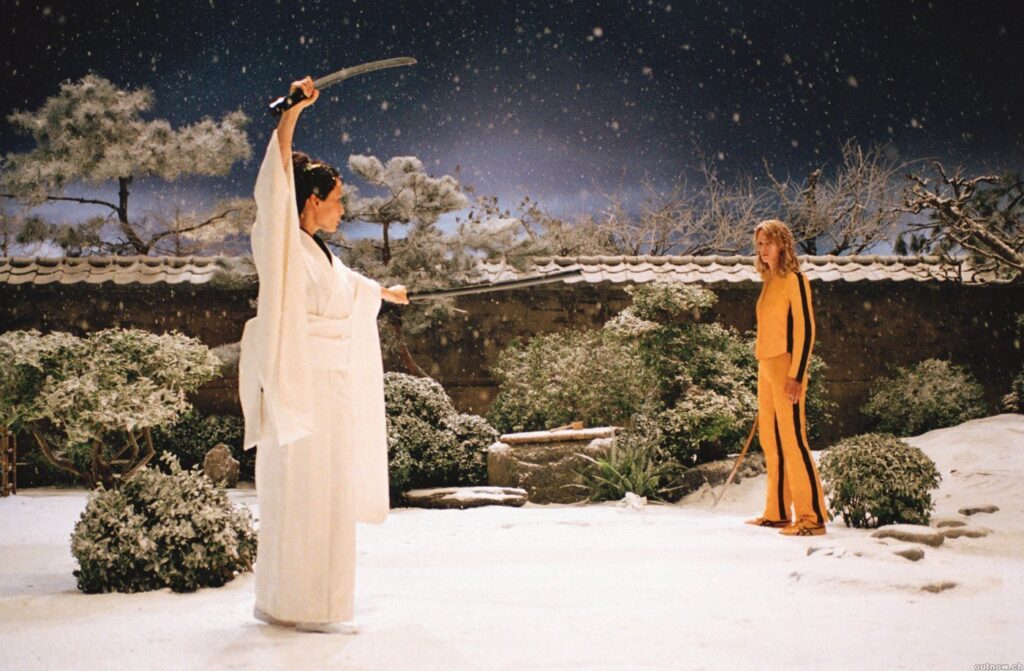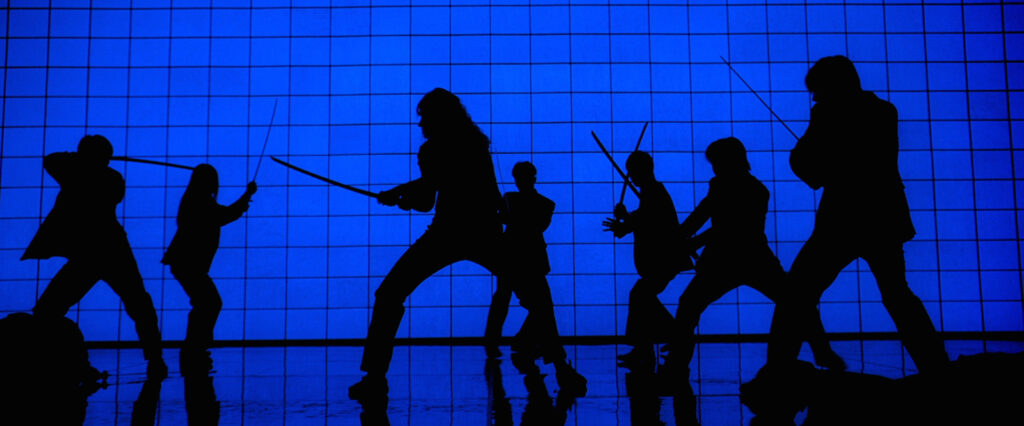Quentin Tarantino’s Kill Bill is more than just an homage to martial arts and revenge thrillers; it’s a stylish, bold display of an action auteur who balances flair with substance. Known for his dialogue-heavy scripts and nonlinear storytelling, Tarantino has often been underrated as an action director. Yet, Kill Bill—a film overflowing with kinetic energy, stylistic confidence, and razor-sharp direction—reveals that Tarantino possesses the instincts of a seasoned action director, albeit with his unique swagger.
Visual Style and Swagger

Tarantino’s distinct style permeates Kill Bill, with each shot composed to highlight the film’s exaggerated, almost mythic violence. The use of bold colors, slow-motion, and creative angles enriches the visual storytelling, transforming each fight into a cinematic experience. This swagger, evident in sequences like the House of Blue Leaves massacre, reflects a playful yet precise approach to action that few directors dare to execute. With seamless transitions between black-and-white and color, along with anime-inspired segments, Tarantino fuses multiple styles to craft a wholly original visual language.
Rhythm and Pacing in Action

While other action films may suffer from relentless pacing, Kill Bill finds its rhythm by mixing moments of stillness with explosive violence. This ebb and flow amplify the tension before each action sequence, giving the audience brief moments to breathe before plunging them back into chaos. The Bride’s methodical journey, punctuated by interludes of reflection and intense confrontations, allows Tarantino to showcase his control over pacing—a skill often overlooked when assessing his versatility as a director.
Creative Choreography and Camera Work

Tarantino’s choice of wide-angle shots and long takes allows the choreography to shine, revealing each combatant’s skill while maintaining a continuous flow. His direction captures the raw athleticism and visceral danger of hand-to-hand combat without relying on choppy editing or CGI. This technique is not only effective but refreshing, proving that Tarantino understands the demands of action choreography and knows how to film it in a way that respects both the performers’ skill and the viewer’s immersion.
Soundtrack as a Narrative Device
The soundtrack in Kill Bill deserves special mention for how it elevates the action sequences. Tracks like “Battle Without Honor or Humanity” serve not merely as background music but as narrative tools that amplify the tone of each scene, adding another layer to the story. Tarantino’s selection of music infuses the action with his signature cool, turning each sequence into a rhythmic spectacle that enhances the film’s swagger.
Subverting Action Tropes

Tarantino doesn’t simply mimic martial arts and revenge cinema tropes; he deconstructs them, adding depth and irony to the genre. By casting Uma Thurman as the Bride—a character with vulnerability and strength—he avoids the standard “invincible hero” trope. She’s ruthless yet relatable, allowing Tarantino to craft fight scenes that are more than mere spectacle—they become a journey of resilience and survival, offering emotional stakes often absent in traditional action films.
Kill Bill is a testament to Quentin Tarantino’s skill as an action director who combines style with substance. His work on this film redefines the expectations of an action movie, blending genre homage with innovation. Through controlled choreography, clever pacing, an evocative soundtrack, and a willingness to embrace stylistic risks, Tarantino asserts himself as a director with a unique, swagger-filled approach to action.

Chaitanya Tuteja is someone who enjoys sharing his thoughts on books, movies, and shows. Based in India, he appreciates exploring different stories and offering honest reflections. When not reflecting on his favorite media, Chaitanya enjoys discovering new ideas and embracing life’s simple moments.


This website features various medical products for ordering online.
You can conveniently buy needed prescriptions without leaving home.
Our product list includes both common solutions and custom orders.
Each item is supplied through verified pharmacies.
https://www.provenexpert.com/risaquad-online2/
We ensure customer safety, with data protection and prompt delivery.
Whether you’re treating a cold, you’ll find trusted options here.
Visit the store today and experience convenient support.
On this platform, you can discover lots of online slots from top providers.
Users can enjoy traditional machines as well as new-generation slots with stunning graphics and bonus rounds.
Whether you’re a beginner or a seasoned gamer, there’s a game that fits your style.
slot casino
The games are available anytime and designed for laptops and mobile devices alike.
All games run in your browser, so you can get started without hassle.
Site navigation is intuitive, making it simple to browse the collection.
Join the fun, and enjoy the excitement of spinning reels!
This website makes available a wide range of pharmaceuticals for online purchase.
Anyone can easily buy essential medicines with just a few clicks.
Our product list includes standard treatments and targeted therapies.
Each item is supplied through trusted pharmacies.
kamagra for women
We maintain user protection, with private checkout and prompt delivery.
Whether you’re filling a prescription, you’ll find trusted options here.
Begin shopping today and enjoy reliable access to medicine.
This website provides a large selection of prescription drugs for online purchase.
Anyone can securely order needed prescriptions with just a few clicks.
Our range includes standard solutions and specialty items.
Everything is supplied through verified providers.
sildenafil oral jelly 100mg kamagra
Our focus is on discreet service, with private checkout and prompt delivery.
Whether you’re treating a cold, you’ll find what you need here.
Explore our selection today and experience reliable online pharmacy service.